Guide to Bernedoodles [Facts & Personality Traits]
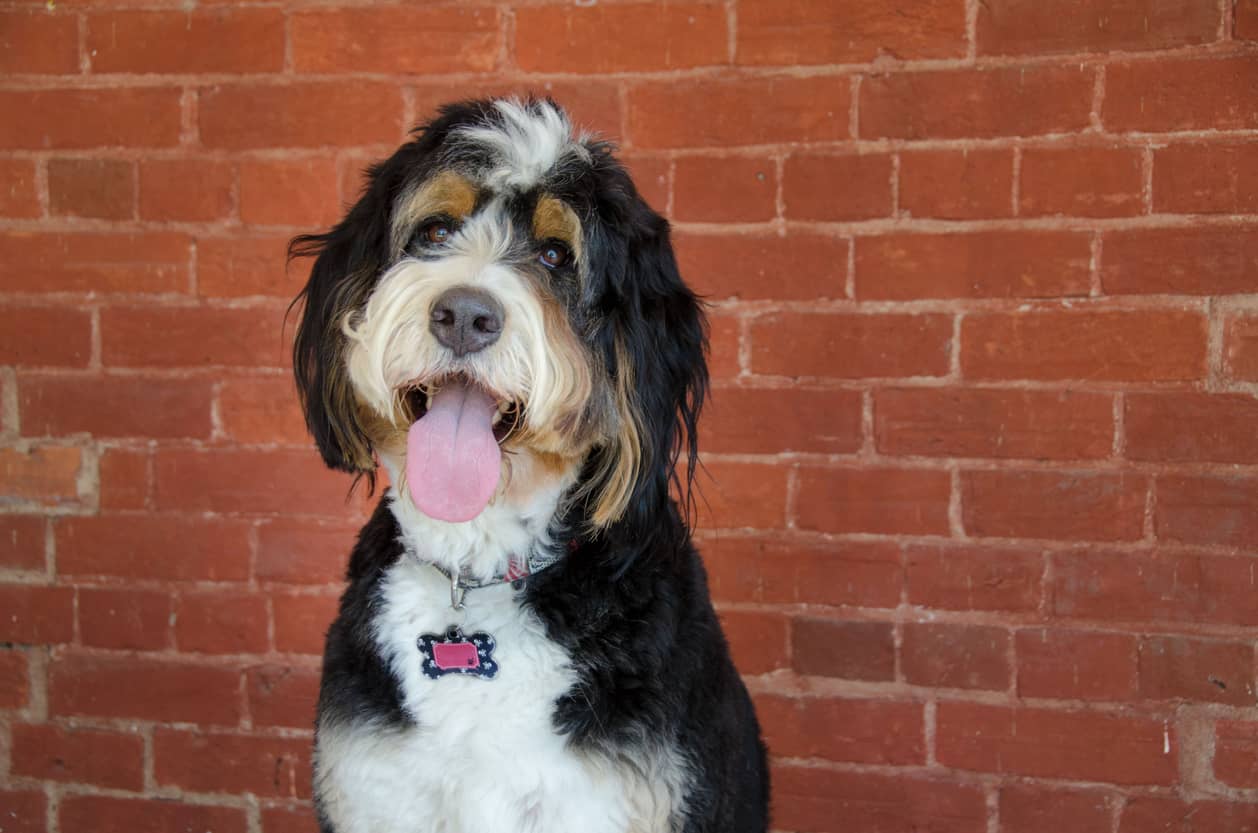
What Is a Bernedoodle?
A cross between a Bernese Mountain Dog and a poodle, the Bernedoodle (or Bernese Mountain Poo) is a lovable, loyal breed that can fit right into almost any household. Intentionally bred as a companion dog, the Bernedoodle is sometimes referred to as a “designer breed,” and therefore is rarely found in shelters. However, there are many passionate breeders dedicated to the humane sale of these healthy hybrids, so prospective Bernedoodle owners can generally feel confident welcoming their new family member from a reputable source.
History of the Bernedoodle

Bernedoodles were first intentionally bred in 2003 by Sherry Rupke, breeder and owner of SwissRidge Kennels in Ontario, Canada. Rupke began breeding Bernese Mountain Dog-poodle mixes for the sole purpose of creating an ideal companion dog, one that was calm, affectionate, loyal and highly intelligent.
Because they are bred more for function than form, Bernedoodles are not show ring-worthy, nor are they officially recognized by the American Kennel Club. However, they are recognized by the American Canine Hybrid Club, the Designer Dogs Kennel Club, the International Designer Canine Registry and the Designer Breed Registry.
Bernedoodle Size & Weight Range (Male vs. Female)
Bernedoodles come in a range of sizes, which is determined by their poodle parent. Like poodles, there are tiny, miniature and standard Bernedoodles. No matter the size, males are generally larger than females.
| Tiny Bernedoodle | Miniature Bernedoodle | Standard Bernedoodle | |
| Height at shoulder | 12-17 inches | 18-22 inches | 23-29 inches |
| Weight | 10-24 pounds | 25-49 pounds | 70-90 pounds |
Bernedoodle Physical Traits
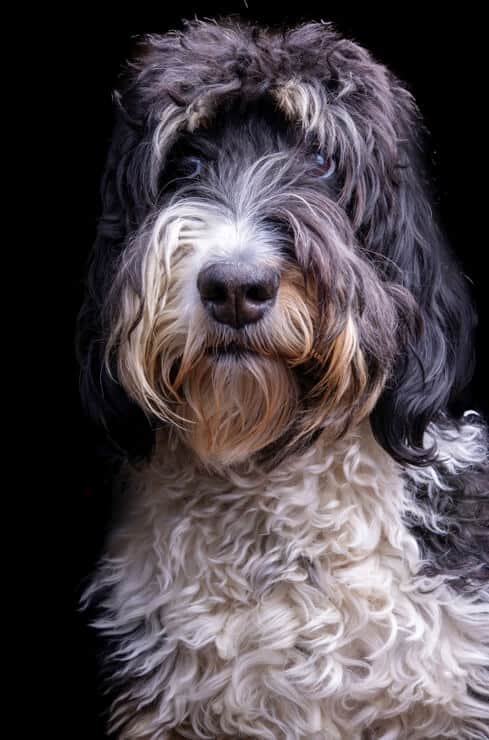
As with any hybrid breed, Bernedoodles may receive more traits from one parent than the other. They may inherit the curly hair of the poodle with the tricolor markings of the Bernese Mountain Dog, or straighter Bernese hair with solid poodle coloring. Bernedoodles are often touted as hypoallergenic, though this is dependent on their coat; the curlier their hair, the more hypoallergenic they are, and vice versa.
Coat
While some Bernedoodles can have either tight curls or straight locks, most tend to look like shaggy (but adorable) teddy bears with wavy coats. The thickness of their coat helps them stay warm, so they are well-suited to colder climates. Bernedoodles’ coats can display a range of colors and patterns: they can be pure black, black with a white bib, or tricolor with black, brown and white patches. Merle (or blue) Bernedoodles have a dappled silver coat, and less common variations include sable and brindle.
Eye Color
Bernedoodles generally have dark brown eyes, although merle variations can have light blue eyes. Heterochromia (two different eye colors) is also possible in this breed.
Bernedoodle Personality
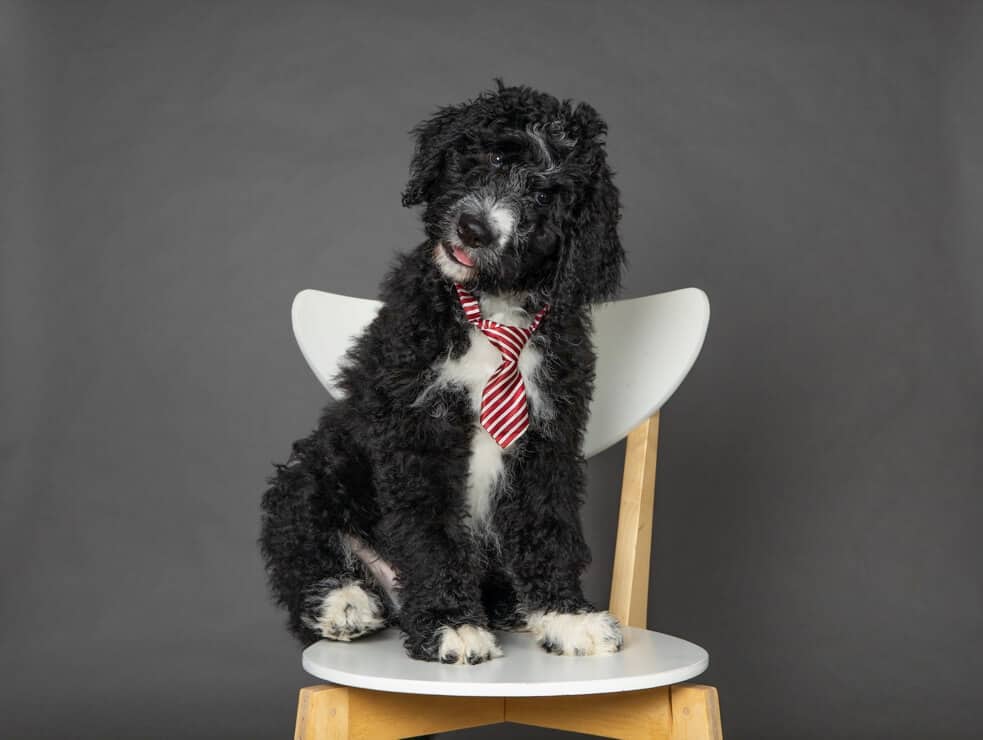
The word most often associated with Bernedoodles is “affectionate”: they love their people, are gentle with children and thoroughly enjoy snuggling with their human family. Along with their love of cuddling, Bernedoodles are highly active and need a lot of exercise to burn off their energy. They are excellent pets for active families with children and access to open space — even if that’s a nearby dog park. Thirty to forty-five minutes of exercise per day is usually sufficient.
Bernedoodles are low droolers and only bark when necessary, such as when they are in distress or perceive their family to be in danger. However, because they are so friendly, Bernedoodles are not recommended as guard dogs, since they have a strong desire to befriend almost anyone or anything.
Bernedoodles inherit intelligence from their poodle parent, which makes them highly trainable — if they feel like listening. In addition to their adaptability and goofiness, they can inherit some stubbornness from their Bernese Mountain Dog parent, a quality that usually fades as they grow from puppyhood to adulthood. Their intelligence also means that they can learn bad habits just as easily as good ones; because of this, Bernedoodles benefit from early training with patient owners or trainers.
Their loving nature makes Bernedoodles ideal therapy dogs, which aligns nicely with their strong desire for attention. Bernedoodles are not recommended for households that are empty for most of the day, since they can become anxious if left alone for long periods of time. Loneliness can cause anxiety and nervous habits like chewing or incessant whining; if they must be left alone for several hours, they can be trained to chew on toys rather than furniture or shoes.
Bernedoodles have a strong work ethic and like to stay busy, which can lead to disruptive behaviors if they are not suitably occupied. They love fetching toys or sticks, swimming and hiking, and may even enjoy being outfitted with a backpack on walks to feel like they are “working.” Doing so may help curb anxious behaviors when they are at rest.
Bernedoodle Lifespan
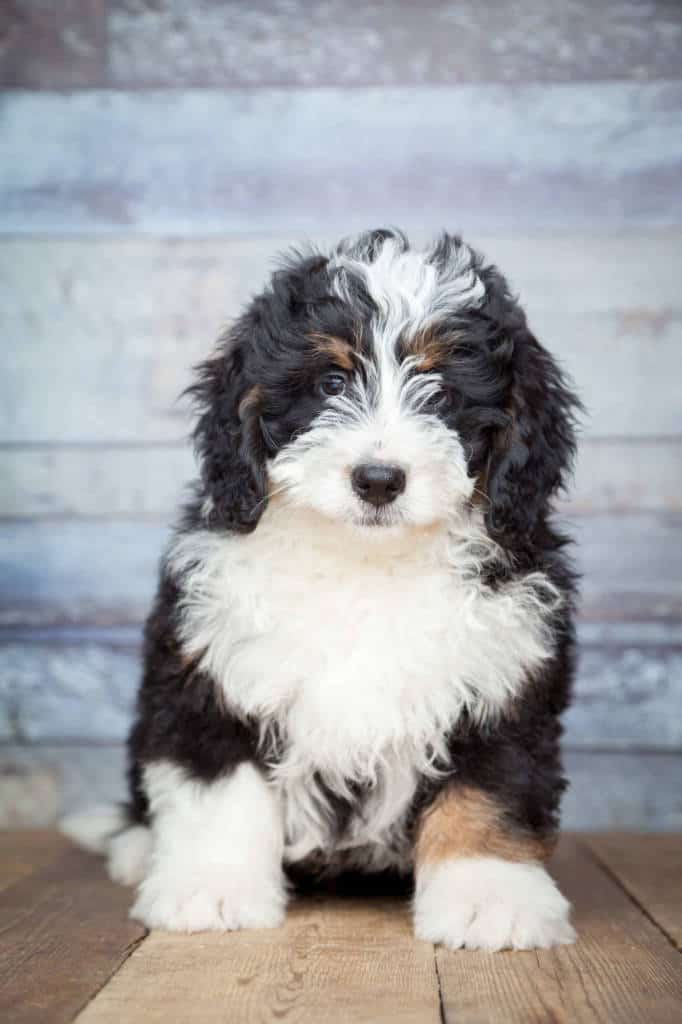
Bernedoodles are a fairly new breed, so information on their lifespan is primarily anecdotal.
Like most mixed breed dogs, Bernedoodles can live anywhere from 12 to 18 years. Tiny Bernedoodles tend to live longer than standards, and all sizes seem to experience relatively few breed-related health issues.
Bernedoodle Common Health Issues
Dogs of any breed can develop health conditions throughout their lives, but hybrids tend to be healthier than purebreds. As with their lifespan, information about health issues specific to Bernedoodles is limited to what owners have observed since they were first bred in 2003.
Poodles and Bernese Mountain Dogs share few health issues between them, so their collective offspring display what is known as “hybrid vigor” and are expected to live longer, healthier lives than their purebred parents. Incidence of cancer seems to be lower in Bernedoodles than either of their parents’ breeds, although they may be predisposed to eye problems and hip and elbow dysplasia.
Their long, curly coats do make Bernedoodles susceptible to skin issues like hotspots, especially if their coats become matted. Bernedoodle owners should brush their dogs’ coats regularly, removing any dirt and snarls that result from outdoor playtime.
Bernedoodle Care & Grooming

Despite their easygoing nature, Bernedoodles are not recommended for owners who have limited time or money to spend on pet care. When it comes to training, according to Sherry Rupke at SwissRidge Kennels, Bernedoodle owners report spending the most time and effort working on:
- Leash training
- Training their dog not to jump on people
- Training their dog not to chew furniture or household objects
- Practicing calm behavior around other dogs and pets
An ideal home for a standard Bernedoodle is a house with a yard or access to outdoor space, while tiny and miniature varieties are perfectly content in apartments. In terms of exercise, Bernedoodles of all sizes are usually satisfied with one long walk a day, 30–45 minutes, depending on their age and size (the smaller or younger they are, the shorter the walk). Owners should be careful not to over-exercise their Bernedoodles to avoid the aforementioned hip and elbow issues.
Due to their long hair, Bernedoodles require a bit more maintenance than other dogs. The curlier their coat is, the less they shed, which means that they need to be brushed to prevent matting. They may also need their coats trimmed every few months, especially if owners do not have the time to groom them regularly.
A Bernedoodle’s typical food intake is about the same as a dog of similar size, depending on their age and activity level. Standard Bernedoodles may be voracious eaters, so owners must take care to monitor their food intake to prevent excessive weight gain. To avoid overfeeding, owners should consider a high-meat, minimally processed diet that will provide their Bernedoodle with optimal clean energy from whole foods.
>Related Reading: How Much Should You Feed Your Dog? Canine BCS Chart & More
Fun Facts About Bernedoodles
- Due to their calm and loving temperament, many Bernedoodles are certified as therapy dogs. Dogs with this certification are enlisted to provide comfort and support to people in nursing homes, hospitals and trauma centers.
- Because of their trainability, the American Kennel Club has bestowed many Bernedoodles with their Canine Good Citizenship award.
- There is a further Bernedoodle variation called an Australian Bernedoodle. This is a cross between a Bernese Mountain Dog and an Australian Labradoodle, which itself is a combination of Labrador Retriever, Cocker Spaniel, Irish Water Spaniel and Poodle.
- Bernedoodles can inherit a herding instinct from their Bernese Mountain Dog parent, so owners may need to train them not to herd neighborhood children or pets.
- Since poodles are water dogs, Bernedoodles inherit a strong swimming gene.
- Like its poodle parent, a Bernedoodle’s coat can fade with age, turning from black to silver or cream.
Are Bernedoodles Hypoallergenic?
Since they generally shed very little, Bernedoodles are considered great dogs for those with allergies to pet fur. However, the straighter a Bernedoodle’s coat, the more they shed and the less hypoallergenic they are.
Do Bernedoodles Get Along with Children?
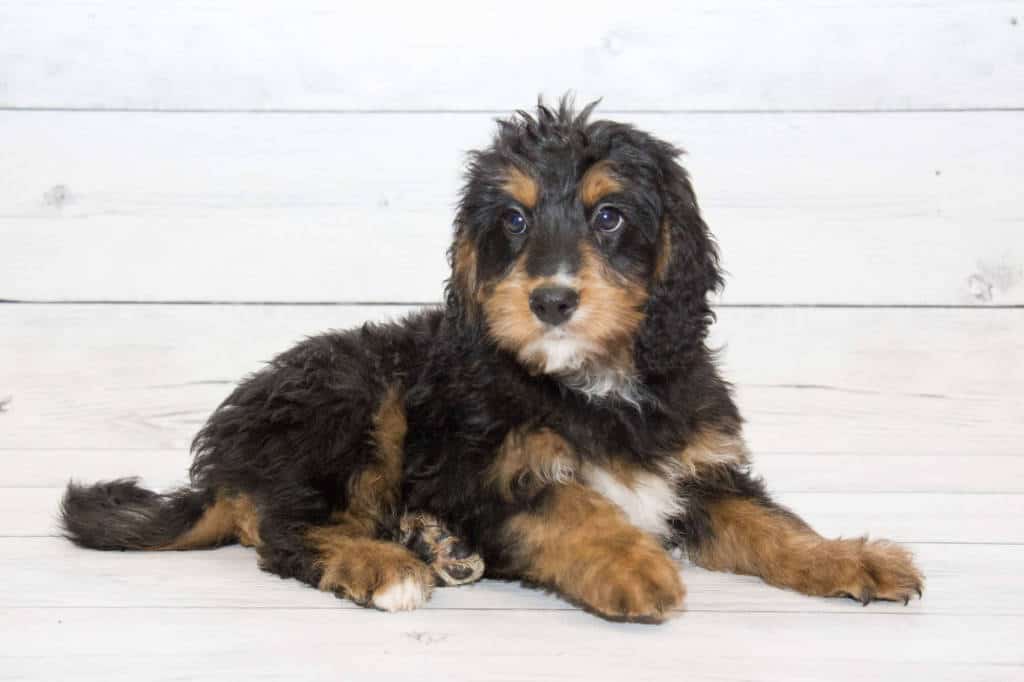
Bernedoodles are very gentle and playful with children, and even make great therapy dogs for kids. Early socialization during their puppy years will ensure that Bernedoodles stay calm around children, strangers and other dogs. It’s also important that children understand how to properly interact with animals, especially smaller Bernedoodles that could be injured more easily during rough play.
Do Bernedoodles Get Along with Other Pets?
The easygoing Bernedoodle is generally tolerant, even fond of other dogs and pets. As with children, early socialization is the key to lifelong positive interactions with other animals.










